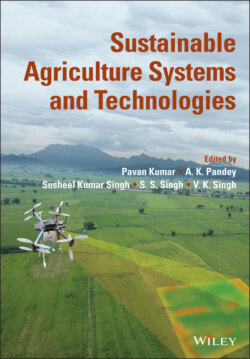Читать книгу Sustainable Agriculture Systems and Technologies - Группа авторов - Страница 17
1.1 Introduction
ОглавлениеIndia is a young nation with the advantage of demographic dividend. Demographic dividend is accompanied with economic growth, provided, good health, education, and employment opportunities exist (Bloom and Williamson 1998; Ross 2004). At present conditions, India will sustain demographic dividend for 37 more years and thus, the health of children is an important aspect as it tells about the past and also the future of the workforce (UNICEF 1998). In 2020, India ranked 94 out of 107 countries in Global Hunger Index, third economy out of 181 in GDP (PPP) and 131 out of 189 countries in Human Development Index. The level of hunger in India is categorized as serious (Global Hunger Index 2020). The child wasting rate is 17.3%, child stunting rate is 34.7%, and under‐five mortality rate is 3.7%; there is a 14% prevalence of undernourished children and a decreasing trend in the global hunger index score since 2000. Although, India ranked 71 out of 113 countries in food security index, and it is noteworthy that it was ranked 37 in food availability, 76 in affordability, 74 in quality and safety, and 98 in natural resources and resilience (Global Food Security Index 2020). Being a leading producer of food grains make it obvious to score well in availability of food but this merely is not enough as quality and safety are also important. Food security is composed of four dimensions, i.e. availability, access, utilization, and stability of the three dimensions over time (FAO 2008). Equitable distribution of food ensures that the good quality, available food reaches the table of every household in the nation. Failing to do so leads to hunger which means distress related to lack of sufficient calories (Global Hunger Index 2019). This leads up to another complex dimension that is malnutrition. Malnutrition refers to deficiencies, excesses, or imbalances in a person's intake of energy and/or nutrients (WHO 2021). The term malnutrition covers two broad groups of conditions one is “undernutrition” and other is overweight, obesity, and diet‐related noncommunicable diseases (WHO 2021). Undernutrition is defined as the outcome of insufficient food intake and repeated infectious diseases, it includes being underweight for one's age, too short for one's age (stunted), dangerously thin for one's height (wasted), and deficient in vitamins and minerals (micronutrient malnutrition) (UNICEF). Stunting is an indicator of chronic undernutrition, the result of prolonged food deprivation and/or disease or illness; wasting is an indicator of acute undernutrition, the result of more recent food deprivation or illness; underweight is used as a composite indicator to reflect both acute and chronic under nutrition, although it cannot distinguish between them (WHO 1995). Undernutrition has been a cause of health issues in developing countries (Rice et al. 2000; Schofield and Ashworth 1996; WHO 2002). This is a matter of concern because; stunting affects the mental development of the child and reduces their productive efficiency (Mendez and Adair 1999). Thus, posing a risk on the future of nations and emerging as a public health challenge. Not only this, the economic losses caused by malnutrition are 11% of GDP every year in Africa and Asia, whereas the rate of return on investment in prevention is $16 for each dollar invested (Global Nutrition Report 2016). Thus, preventing malnutrition is an economically viable option.
India is opting for a multipronged approach to tackle the burden of malnutrition through nutritional programmes like Mid‐day meals, Integrated Child Development Programme, Public Distribution System (PDS), National Nutrition Mission, Bio‐fortification, etc. Bio‐fortification is the process of using conventional plant breeding techniques to enrich staple food crops with higher level of vitamin A, zinc, and iron. PDS in India covers a large amount of beneficiaries who are unable to afford a minimum dietary requirement. Distribution of bio‐fortified wheat though PDS can help uplift the nutritional status of the majority. Sustainable development goals setup in 2012 have given a blueprint of actions needed to be taken for ensuring a safe and sound future for the upcoming generation. Zero hunger, as the second goal says, it targets to end hunger, ensure food security, and achieve sustainable agriculture development. And our performance in the SDG index is important on global scale as one‐sixth of world population resides in India. In the SDG India Index 2020, nutrition and gender equality have a long road to take to perform well in the score. Occurrence of pandemic like COVID‐19, where complete closure of economic activities has been witnessed, also threatens the nutrition security of the population (specially the unorganized sector). The slow economic growth rate due to COVID‐19 will lead to reduced aggregate demand, consumption expenditure, and hamper income as well as food security (IFPRI 2015). Thus, it becomes important to point out where we are at the nutritional level, how much have we have improved and what are the factors responsible and associated with the prevalence of under‐nutrition.
